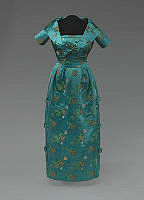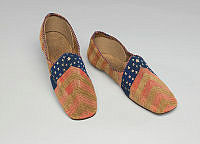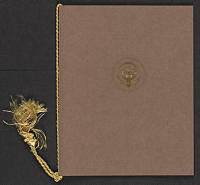Rubenstein Center Scholarship
An Early Black Family's Life in Lafayette Park
This article is part of the Slavery in the President’s Neighborhood initiative. Explore the Timeline
As we consider life in the President’s Neighborhood, the unusual story of the Wormley Hotel and its Black founder, James Wormley, should come to mind. It was one of the preeminent private hotels in Washington, D.C. and the establishment of choice for foreign dignitaries, politicians, businessmen, and the wealthy in the latter half of the nineteenth century. Stories about life in the President’s Park usually feature the white residents and exclude the experiences of free Blacks. The Wormley Hotel—an important establishment owned and operated by a family of color at a time when Blacks were deemed incompetent, ignorant, and subhuman—seems incongruous with the patterns of society during that era. The Wormley family showed incredible perseverance, fortitude, and intellect as it overcame systemic obstacles while competing against white competitors. The Wormley family’s entrepreneurial spirit, aided by relationships with white politicians, diplomats, and business leaders, established a foundation for the ultimate success for James and his hospitality-related enterprises. While running a business, the Wormley family were also integral members of the Black community and fought for civil rights in and around the President’s Park on a daily basis for almost the entire century. This article explores how the Wormley Hotel, a refined and prominent black-owned establishment initially rose to success in a southern city built on slavery and riddled with racial discrimination.

In 1819, James Wormley was born into a family of free Blacks living in Washington, D.C. His mother and father, Lynch and Mary (Polly) Wormley, arrived in Washington in the spring of 1814 as the War of 1812 was threatening the city. They had recently left Albemarle County, Virginia, after living with and adjacent to the Coles family, a group of wealthy Virginia planters with extensive social and political connections. Lynch and Mary Wormley moved to D.C. to pursue better economic opportunities for their growing family and to escape the law regarding recently manumitted slaves in Virginia which required leaving the state within one year, raising eventually ten children. They also hoped to leverage their connections with some of the nation’s early leaders, including James and Dolley Madison, John Tayloe, Thomas Jefferson, James Monroe, Henry Clay, Daniel Webster, General Winfield Scott, Richard Rush, and others. Click here to learn more about the enslaved households of President James Madison, President Thomas Jefferson, and President James Monroe.
We have little information about where the Wormleys resided during their early years in the District. However, their home may have been near President’s Park. The earliest documentation of their presence in proximity to the White House is a letter from Sarah (Sally) Coles written from the Coles plantation, Enniscorthy, to her cousin Dolley Madison at the President’s House on June 28, 1814. In that letter, Sally tells Dolley that Anna Cutts' feelings (Dolley’s sister) toward Polly could be described as “…her benevolence was never excited by a more worthy object than this poor Girl who is one of the best, most faithful, and trusty creatures in the world.”1 From the correspondence between Sally and Dolley, and the ensuing years of support, we can surmise that the entire Coles family admired Mary Wormley before her arrival in the District with Lynch. It is possible that her father was related to one of the Coles male relatives, as she was described in subsequent newspaper accounts as nearly Caucasian in appearance.2 The relocation of Polly and Lynch to the District has been confirmed by a series of letters located in the files of the current Coles family, which detail that they were allowed to relocate in the spring of 1814 in order to be less of a financial burden to the Coles family. The letters indicate that the Coles paid other plantation owners like James P. Cocke to feed and shelter Lynch, Polly, and their family while residents on their property.3

Lynch Wormley court complaint for freedom confirmation and request for ‘Certificate of Protection” filed by Francis Scott Key on July 10, 1815.
National Archives and Records AdministrationThat following summer, Francis Scott Key filed a petition confirming that Lynch was a free man in the Washington County Court. The petition also included a request to grant Lynch a “Certificate of Protection” which permitted him to continue living in the District as a free man while this legal matter proceeded.4 To obtain this license as a Black man, Lynch had to provide evidence of his free status. This freedom documentation was the only way he could continue to be engaged in his business.
Lynch clearly knew how to make the most of his network of acquaintances. He was connected to the prominent Wormeley family of Virginia, whose plantations were scattered across the state. Family oral histories, ephemera, and tradition suggest that Lynch originally lived as a free person with one of the Wormeley scions, James Wormeley, at one of the family plantations known as the “Rocks” near Charles Town, Virginia. When that James Wormeley sold the “Rocks” in 1798 he moved with his son to England. Lynch then likely relocated to Albemarle County, near Enniscorthy and the Coles family to work as the “mill man” at Cocke’s new flour mill at his plantation, Edgemont.
Eleanor Tayloe Wormeley, the wife of the late eighteenth-century family patriarch Ralph Wormeley, was the aunt of John Tayloe III, another wealthy Virginia planter who had built the Octagon House near the White House. The Tayloe and Wormeley families, whose primary family plantations were located along the banks of the Rappahannock River in Middlesex County, Virginia, were neighbors and social intimates. Lynch knew Eleanor Wormeley and the Tayloes along with his lawyer, Francis Scott Key. Key was also part of a close circle of friends, including the Madisons, Cutts, Richard Rush, and the Coles. From these interconnected families, we can speculate on how Lynch came to be represented by Francis Scott Key.

Certificate from Edward Coles confirming the freedom of Lynch from James P. Cocke, filed January 28, 1820.
National Archives and Records AdministrationEdward Coles, the personal secretary to President James Madison, also offered significant aide to Lynch Wormley and his family. Records indicate that the original lawsuit Key filed on behalf of Lynch remained dormant until 1819. During that time, pursuant to the original “Certificate of Protection”, Lynch Wormley purchased a used hackney carriage and harness for two horses for $150.00. A Bill of Sale recorded on December 17, 1818, indicates that he used a series of notes payable to a William (Will) Galloway to make this purchase. Lynch then obtained a license to drive the hackney.5 A little more than a year later, Lynch defaulted on these notes and was at risk of being sold into slavery in the Deep South, a common punishment at the time for Black people unable to settle their debts. On January 12, 1820, Coles secured a statement signed by J. P. Cocke, which acknowledged Lynch’s free status and protected him from being sold into slavery. This document was then mailed to Edward Coles in “Washington City” in an envelope postmarked “Jan 15” from Charlottesville. On January 28, Edward Coles filed a certification with the court in that original 1815 case stating that Lynch had “… given satisfaction as to the claims of James P. Cocke Esq. The latter is content that Lynch shall go free…” and praying that Mr. Jones dispose of the suit so as to confirm Lynch’s title to freedom.6
Coles became involved in this lawsuit because he had a long history with Lynch and Polly. He knew Polly from her time at Enniscorthy and the Coles family had provided financial support for Polly and her family prior to their move to D.C. James P. Cocke had employed Lynch at his mill which was located just a few miles from the Coles plantation.
Coles’ timely court intervention came just as Lynch defaulted on his promissory notes and Galloway attempted to recover his funds. The used carriage Lynch purchased from Galloway did not endure the wear and tear of the business and broke down after just a few months. Lynch tried to repair it, but without a consistent income, he was unable to pay off his debts. On February 29, 1820, William Galloway executed a complaint against Lynch for the balance of the purchase price ($85) for the carriage and harniss (sp) and for repairs ($130) which was filed March 2 and heard by consent on April 1.7 Fortunately, just prior to this demand, Lynch procured his final freedom documentation with the assistance of Edward Coles, thereby avoiding slavery to pay those debts. Although we do not know how Lynch raised the funds to pay Galloway, it is possible that Coles offered assistance. Coles, a former slave owner turned abolitionist, had just recently freed all of his own enslaved people, transported them to Illinois, and gave them land to support their families.8

This real estate assessment record shows the change of property ownership from Richard Rush to Lynch Wormley.
National Archives and Records AdministrationJust a few years prior to the resolution of this case, many members of this same social circle known to Lynch formed The Society for the Colonization of Free People of Color of America, more commonly known as the American Colonization Society (ACS).9 One of the original purposes of the committee was to assist free Blacks in forming their own, separate society in the United States, while facilitating the establishment of an independent colony in Africa. A number of ACS members actively assisted Lynch and his family to surmount the impediments for a free man of color. During this time period, Lynch and his family purchased a home from Attorney General Richard Rush, a member of ACS, near the intersection of 18th and I Streets NW.

An advertisement for tax sale of Lynch Wormley's property (previously purchased from Richard Rush) dated October 25, 1825.
The Daily National IntelligencerIn 1827, Richard Cutts, Dolley Madison’s brother-in-law, was in financial straits after he failed to sell the lots he had purchased during the early construction of the Federal City. On April 26, through his bankruptcy trustee and neighbor Richard Smith, Cutts sold a house and stables to Lynch on the south side of E Street, where the Commerce Department headquarters stands today. Lynch’s personal relationships likely helped facilitate this sale. Cutts probably would not have thought of selling a house to Lynch because of his checkered financial past. He was certainly not a promising candidate to purchase real estate in downtown Washington.10 Just a few years prior, Lynch had purchased a home from Richard Rush on I Street near 18th. After he failed to pay taxes on the property, it was then scheduled for auction. The year after Lynch bought the E Street property, he was arrested for defaulting on debts once again, only to be released one week later pursuant to a bond so he could earn funds to pay his obligations. Without his personal relationships, Lynch probably would not have been successful in acquiring the stables on E Street, which became the center of his hack business enterprise.
Meanwhile, Obadiah B. Brown, the pastor of the somewhat integrated First Baptist Church, was the religious guide for the Wormley family during those early years. Records indicate that Mary was accepted into Reverend Brown’s congregation on November 22, 1818, at a church meeting at the house of Sister Isabella Craven. Mary, a free woman of color and wife of Lynch, is accepted into the church according to an entry in the first volume of the Minutes of the 1st Baptist Church.11 Other members of the family followed Mary’s lead, becoming members in the following years. Lynch himself became a member on December 7, 1839. Around this time, many Black members of the church left to form their own church. They purchased the original structure and the white church members moved to a new building near what would become the famous Ford’s Theatre. The Wormley’s probably moved with the white church because Reverend Brown performed the marriage ceremony for the most famous member of the family clan--James C. Wormley, when he wed Anna Elizabeth Thompson on January 31, 1841. Reverend Brown also served as a board member for the Bank of Metropolis with William Corcoran and what would become Columbian College with Benjamin Ogle Tayloe. Both of these men were friends with James and played very important roles in the development of James and his Wormley Hotel in the second half of the century.

This document shows that Mary Wormley became a member of the First Baptist Church originally located on 19th Street NW on November 22, 1818.
Minutes of the First Baptist Church, vol. 1. , Historical Society of WashingtonDuring this period, William, another son of Lynch and Mary, became highly active in the growing civil rights movement. In December 1826, William Wormley, Charles Syphax, John F. Cook, and others put up $5 each to purchase land to bury free persons of color. The cemetery was known as Harmoneon and located between 6th and 7th, and S and Boundary. William was also a founding member of the District of Columbia chapter of the Freemasons in Lodge #7 on June 6, 1825.12
From May through September 1831, William was the District of Columbia agent for The Liberator, the Boston abolitionist paper published by William Lloyd Garrison. At the time, intense fear over slave uprisings such as Nat Turner’s Rebellion in Virginia, spurred local governments to pass laws calling for criminal prosecution of anyone involved in the distribution of materials which would possibly foment unrest in the Black community. On October 28, the court charged William and on November 9, 1831 a summons was issued for his arrest. William and his brother, Owen Wormley, posted a bond of $200 on November 19, 1831 to assure that William would appear on December 1 in court.13 A few months before, William Wormley was elected as Vice President for the District of Columbia at the First Annual Convention of the People of Color held in Philadelphia.14

Record of William Wormley's criminal charge for being the District of Columbia agent for The Liberator.
National Archives and Records AdministrationDuring these years Lynch repeatedly was designated “prison bound” for what would appear to be nominal debts (frequently less than $50) only to again be released on bond to earn money to repay the obligations. In the 1830s, a Black person arrested for an outstanding debt had to provide evidence of his freedom or risk being sold into slavery. On multiple occasions Lynch, with the assistance of other free blacks like John Prout, obtained replacement copies of his freedom documentation from the Albemarle County Court House.
By May 1830, Lynch amassed additional real estate near President’s Park. Susan Decatur was unable to pay for the personal services of John, another son of Mary and Lynch. To satisfy her financial obligations to the Wormleys, Mrs. Decatur gave them a house and lot on I St. NW near 15th Street. This house, along with four other adjoining parcels, became the nucleus of what was to become the Wormley Hotel Annex.
The winter of 1834-1835 was a difficult time for Mary and Lynch. On September 10, 1834, they lost their son Owen after a lingering illness. Less than five months later on January 27, 1835, their nineteen-year-old daughter Mary also died. Mary had been educated in Philadelphia at the Sarah Douglass School and was working as the educator for free Black children at the school William had built on I Street near 15th behind the family home. The following August, the Snow Riots occurred as mobs terrorized members of the free Black community, causing William to flee the city for a period after the school was burned.15

Tax record for the building used for the William Wormley schoolhouse for free black children to the rear of one of the Wormley houses on I Street
National Archives and Records AdministrationIn June of 1837, Lynch purchased a “coachee” from Mr. Matthew St. Clair Clarke, the clerk of the House of Representatives. According to the 1840 census, St. Clair Clarke lived four families away from William Wormley on I Street NW and 15th. Matthew St. Clair Clarke was the original builder of the Ashburton mansion next to St. John’s Church (eventually becoming its parsonage) before he was forced to sell it. He also was an active member of the American Colonization Society.
After Mary died in 1842, Lynch continued living in the building on E Street but relinquished his role as the family patriarch as his children, especially James, grew into their adult lives. Lynch went on to operate the “Liberia Hotel” on E Street between 14th & 15th Streets, NW as of 1845.16 Before he died in 1851, he witnessed his children’s success after they branched out from the hack business. James, his most successful son, became a caterer and hotelier of international renown whose establishment, even prior to the Civil War, was held in the highest regard by the leading political figures in the United States and European travelers seeking a place of refined accommodation in the District of Columbia. Anthony Trollope, the famed European writer in his book about his visit to the US in 1861 stated: – “I am bound to say that my friend did well for me. I found myself put up at the house of one Wormley, a colored man in I Street…I conceived myself to be greatly in luck.”17 The hotel grew from a small boarding house in the early 1850s on I Street to a row of five adjoining houses. This collection of buildings served as the residence of General Winfield Scott while he stayed in the city, the restaurant where General George McClellan entertained his officers, and where members of Congress, the cabinet, and the Supreme Court entertained their guests.

A copy of the deed from Susan Decatur to Mary Wormley for a house on I Street near 15th NW in exchange for the services of John Wormley, the son of Mary Wormley.
National Archives and Records AdministrationIn 1869, James incorporated a mansion on the corner of 15th and H Street as his main establishment thereafter designating his row of houses as “Wormley’s Annex”.18 In 1871, he refurbished and expanded the mansion structure to better accommodate the status of this building as the primary facility.19 For the next twenty years this establishment continued to be the hub for business, political, and social activity, hosting events like the 1878 Spanish Ball. The Spanish Minister Mantilla hosted members of the diplomatic community at Wormley’s for the celebration of the wedding of King Alphonso XII of Spain. In an article in the Evening Star on January 24, 1878, the grandeur of the event was dramatically described as one of the finest social events of the season. The hotel was also the meeting place of choice for politicians where they could meet to conduct meetings and be sure their conversations remained confidential.
James enjoyed friendships with many of the nation’s leadership on both sides of the color line. The close relationship between the James Wormley and Frederick Douglass families proved to be long lasting with their respective sons serving together during the Civil War and thereafter with the fathers frequently dining together to discuss matters of importance for the Black race.20
After serving as the host for presidents, visiting foreign dignitaries, and businessmen like W. W. Astor, Louis Comfort Tiffany, and Alexander Graham Bell, James passed on October 21, 1884. His funeral was attended by thousands, as well as luminaries such as William Corcoran, who described him as one of the city’s finest citizens.21 The hotel continued to hold that place of distinction for another decade under the management of his son, Dr. James T. Wormley, until the financial crash of 1893 when the end of Reconstruction and competition from larger, well-funded hotels like the new Sheraton across the street brought about its closure.
None of the Wormley clan’s success could have come to pass without the aid and assistance of the other residents of the President’s Neighborhood, both black and white. Upon reflection, one is left to wonder what went on in the minds of this free family of color, their white supporters, enslaved individuals in the neighborhood, and those who supported the institution of slavery in the nation’s capital regarding this evil, all at a time when slave coffles were marched down the street to be sold into a lifetime of human bondage.
Donet D. Graves (Don) is an attorney based in Cleveland, Ohio. He has presented to a number of organizations aspects of his study of the Wormley family’s Washington, D.C. experience. His discussion revolves around the role of the Wormley family in and around Lafayette Square as free people of color, influencing life both in the District and the nation.










